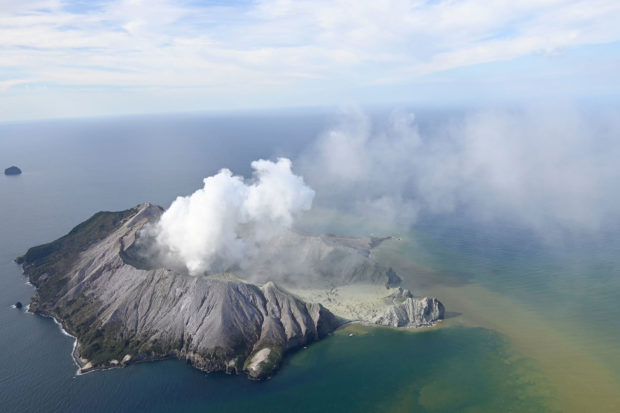WHAKATANE, New Zealand – A volcano off the New Zealand coast erupted Monday with a towering blast of ash and scalding steam as dozens of tourists were exploring its moon-like surface, killing five people and leaving eight others missing and feared dead, authorities said.

This aerial photo shows White Island after its volcanic eruption in New Zealand Monday, Dec. 9, 2019. The volcano on a small New Zealand island frequented by tourists erupted Monday, and a number of people were missing and injured after the blast. (George Novak/New Zealand Herald via AP)
Helicopter crews landed on White Island despite the danger and helped evacuate the dozens of survivors, some of them critically injured.
Hours after the disaster, authorities said the site was still too dangerous for rescuers to search for the missing. But aircraft flew over the island repeatedly, and “no signs of life have been seen at any point,” Prime Minister Jacinda Ardern said.
The missing and injured included New Zealanders and tourists from the U.S., China, Australia, Britain and Malaysia, the prime minister said. Some of those who were exploring the volcano were passengers from the Royal Caribbean cruise ship Ovation of the Seas, docked on neighboring North Island.
“My god,” Michael Schade tweeted as he posted video of the eruption. “My family and I had gotten off it 20 minutes before, were waiting at our boat about to leave when we saw it. Boat ride home tending to people our boat rescued was indescribable.”
His video showed a wall of ash and steam around White Island and a helicopter heavily damaged and covered in ash. He said one woman was badly injured but seemed “strong” by the end.
The terrifying disaster immediately raised questions of why people were allowed to visit the island some 30 miles (50 kilometers) off mainland New Zealand after scientists had noted an uptick in volcanic activity in recent weeks. White Island is the tip of an undersea volcano.
Authorities said 47 people were on the island at the time. Some were walking along the rim of the crater just before the eruption. In addition to the dead and missing, 31 survivors were hospitalized and three others were released, officials said. Some of the victims were reported severely burned.
The eruption took place about 2 p.m. and consisted of two explosions in quick succession, the prime minister said. It sent a plume of steam and ash an estimated 12,000 feet (3,660 meters) into the air. One of the boats that returned from the island was covered with ash half a meter (yard) thick, Ardern said.
The GeoNet agency, which monitors volcanoes and earthquakes in New Zealand, had raised the alert level on White Island on Nov. 18 from 1 to 2 on a scale where 5 represents a major eruption, noting an increase in sulfur dioxide gas, which originates from magma deep in the volcano. It also said that volcanic tremors had increased from weak to moderate strength.
Ardern said White Island is a “very unpredictable volcano,” and questions about whether tourists should be visiting will have to be addressed, “but for now, we’re focused on those who are caught up in this horrific event.”
Brad Scott, a volcanologist with research group GNS Science, said the alert level on White Island is often raised and then dropped without any eruption. He said there hadn’t been any major problems with tourists visiting the island in the past, though there had been some close calls.
He would not venture an opinion on whether it was safe enough for tourists immediately before Monday’s eruption.
After the disaster, GeoNet raised its alert level to 4, later dropping it to 3.
“In the scheme of things, for volcanic eruptions, it is not large,” said Ken Gledhill from GeoNet. “But if you were close to that, it is not good.”
White Island is New Zealand’s most active cone volcano. About 70% of the volcano lies under the sea.
Twelve people were killed on the island in 1914 when it was being mined for sulfur. Part of a crater wall collapsed and a landslide destroyed the miners’ village and the mine itself.
The remains of buildings from another mining enterprise in the 1920s are now a tourist attraction. The island became a private scenic reserve in 1953, and daily tours allow more than 10,000 people to visit every year.
The island is also known by the indigenous Maori name Whakaari.